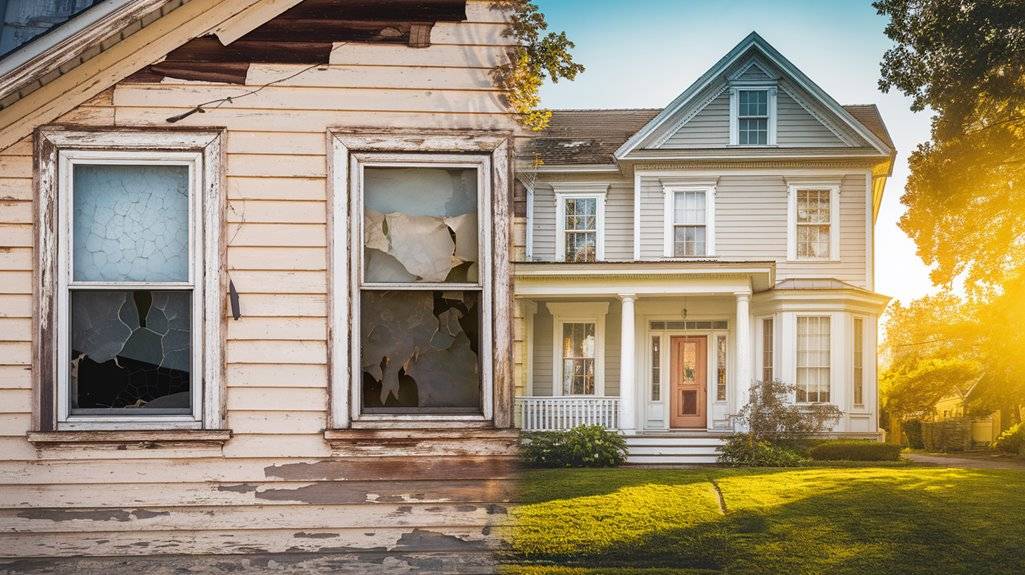Selling your home can be a tough decision, especially when deciding between selling as-is or making repairs first. This choice affects your time, money, and stress levels. Should you avoid the hassle or invest in fixes?
It’s a dilemma many homeowners face. But here’s the catch—selling as-is might save time, yet it often lowers your home’s price. Repairs can boost value, but they cost money and delay your sale. The wrong choice could mean lost profits or added frustration. So, what’s the best move?
Selling as-is or making repairs depends on your goals, budget, and market trends. We’ll break down both options to help you decide. With clear insights, you can choose confidently and maximize your sale. This blog will guide you through the decision, ensuring you pick the right path for your home sale.
Key Takeaways
- Selling as-is saves time and repair costs but often results in a lower sale price.
- Making repairs can increase sale price and attract more buyers with a move-in-ready home.
- As-is sales appeal to investors, while repairs broaden the buyer pool significantly.
- Repairs involve high upfront costs and potential delays, risking budget overruns.
- Market conditions influence the choice; seller’s markets favor as-is, buyer’s markets favor repairs.
Can You Sell a House As-Is?

Yes, you can sell your house as-is. It’s possible, but understanding the market is key. In a seller’s market, buyers often accept fixer-uppers. If it’s a buyer’s market, expect lower offers or harder talks.
Local zoning laws also matter when selling. They can limit what buyers do with the property. If rules restrict renovations, buyers might hesitate. Researching these laws helps you prepare. Stay informed to avoid surprises during the sale. Make smart choices to get the best result. Selling as-is often attracts investors and flippers who seek properties with potential for profit.
What does it mean by Selling “As-Is”?
When you sell a house “as-is,” you’re offering the property in its current condition, with no promise to fix any issues before closing. You’ll find that this approach has clear advantages, like saving time and money on repairs, which we’ll discuss under the pros of selling as-is. However, don’t overlook the potential drawbacks, such as a lower sale price or limited buyer interest, which we’ll analyze among the cons. This method is particularly beneficial for those needing a quick sale, as it allows you to sell without repairs and move forward without delay.
Pros of Selling a House As-Is
When you sell your house “as-is,” you’re offering it in its current condition, with no promise to fix anything, which can bring several advantages. You’ll likely speed up the sale, cut costs on repairs, and attract investors looking for a deal, all while avoiding the hassle of managing renovations. Let’s examine how these benefits—faster sales, lower expenses, investor appeal, and reduced stress—can make this option a strategic choice for you.
Faster Sale
Selling your house “as-is” can speed up the process significantly. It attracts buyers who value quick deals over property condition. Investors often look for such homes to close fast. If you skip repairs, you avoid delays from renovation timelines.
Economic trends also push these rapid sales in changing markets. Buyers hunt for bargains during uncertain times. If markets fluctuate, cash buyers might act quicker to secure deals. Agents target these buyers to ensure a swift close.
Their strategies focus on avoiding buyer contingencies for faster transactions. If you choose this path, closing happens without waiting. This approach works well for those needing a quick sale. It becomes a smart choice under time constraints.
Lower Costs
Selling your house “as-is” cuts upfront expenses. It helps you avoid spending on costly repairs before selling.
Consider these advantages:
- You save money on renovation costs.
- Contractors’ high fees won’t burden you.
- Unexpected repair costs can be dodged.
- If eligible, you might get tax deductions.
- Upgrades for energy savings aren’t necessary.
If you sell “as-is,” your budget stays safe. You won’t waste money on fixes you won’t use.
Attracts Investors
Selling a property “as-is” often draws savvy investors looking for a deal. They aim to buy low and fix homes for profit. These buyers spot chances in undervalued properties with potential. If you sell as-is, your home becomes a tempting target for them. Their goal is turning it into a money-making investment quickly.
Less Hassle
Selling your house “as-is” offers a simple way to avoid stress and extra work. You can skip tough repairs. Homeowners bypass delays from contractors if they choose this path. They also save money by avoiding renovation costs. This option cuts down stress from tight selling timelines. Instead, you focus on planning your next step. If you sell “as-is,” you’ll save time and keep your energy for what matters most.
Cons of Selling a House As-Is
When you opt to sell your house as-is, you’re likely to face a lower sale price since buyers factor in the cost of needed repairs. You’ll also encounter a limited buyer pool, as many potential purchasers shy away from properties requiring significant work. On top of that, expect negotiation challenges, as buyers often push for steeper discounts to offset the risks of buying in the current condition.
Lower Sale Price
Selling a house “as-is” often means a lower sale price. Buyers account for repair costs when making offers. Here are some key points to understand:
- Buyers usually demand discounts for visible problems.
- Your home faces tough competition in a crowded market.
- High interest rates might discourage potential buyers.
- Obvious flaws can lower the home’s perceived worth.
- If issues persist, your negotiation strength weakens greatly.
This reduction directly affects your overall profit.
Limited Buyer Pool
Selling a house “as-is” reduces your pool of potential buyers significantly. You attract mainly cash buyers or investors. Most traditional buyers need financing, which often requires a home in good condition. If regional demand is low, fewer people might consider a fixer-upper. This can shrink your market even more.
Negotiation Challenges
Selling a house “as-is” creates negotiation challenges due to buyer expectations. Buyers often demand big price reductions. This puts sellers at a clear disadvantage during talks.
If buyers push hard, they may want steep discounts. Sellers might show limited willingness to make repairs. Inspection issues can surprise both parties involved. Some buyers hesitate due to emotional concerns. Competing against renovated homes adds extra pressure.
If you strategize well, you can handle these tough discussions. Use smart tactics to counter low offers. Navigate market changes to secure a fair deal.
Repair a House First. Get Listed and Sell It
When you choose to repair your house before listing it, you’re possibly increasing its market value and attracting more buyers with a move-in-ready property. However, you’ve gotta weigh the upfront costs and time investment against the possibility of not recouping those expenses in the final sale price. Let’s break down the pros and cons to help you make a sharp, informed decision. Keep in mind that addressing foundation issues before selling can significantly improve buyer confidence and potentially mitigate a decrease in property value.
Pros
When you choose to repair your house before listing it, you’re positioning yourself for a higher sale price by showcasing a property in top condition. These upgrades also broaden buyer appeal and speed up marketability, as potential buyers won’t hesitate over needed fixes. Plus, you’ll gain a competitive edge in a crowded market, standing out against homes sold as-is.
Higher Sale Price
Want to increase your home’s value before selling? Simple repairs and upgrades can raise your sale price significantly. Strategic changes can improve appraisal results and boost your negotiation power.
Here are key improvements to consider:
- Structural fixes ensure safety for buyers.
- Updating old plumbing prevents future issues.
- Fresh paint boosts visual appeal instantly.
- Roofing repairs protect against leaks.
- Energy-efficient upgrades save money long-term.
If you invest smartly, you could see a better return when listing.
Broader Buyer Appeal
A well-maintained home can attract a wider range of buyers. If you enhance Curb Appeal, more people will feel interested. Diverse buyers might imagine living in your space with ease. Use Virtual Tours to highlight repairs clearly. Prospects will notice the value right away. Your house becomes a ready-to-love home for many. If marketed well, it can appeal to a broader audience.
Faster Marketability
Repairs can make your home sell faster by preparing it for the market. They attract buyers with a polished look. If you fix issues, your home gets listed quickly. This saves time and boosts interest.
Enhance marketability with these steps:
- Virtual tours that highlight recent fixes.
- SEO tools to increase online visibility.
- Building trust with potential buyers.
- Minimizing delays during price talks.
- Speeding up the final closing process.
If you act now, repairs could shorten selling time!
Competitive Edge
Your home can stand out in a busy market with the right steps. Fixing issues before listing boosts your advantage. Upgrading key spots aligns with global trends that buyers love. If you add modern touches, you’ll attract more interest. Tech features like smart home systems make a big difference. When you integrate these, discerning buyers notice your property. Higher prices become easier to justify with such upgrades. Deals close faster in today’s trend-focused real estate world.
Cons
When you choose to repair a house before listing it, you’re signing up for significant upfront costs that can strain your budget before seeing any return. You’ll also find the process incredibly time-consuming, as coordinating contractors and managing renovations often drags on longer than expected. On top of that, unexpected expenses can hit hard, with hidden issues like plumbing or structural damage adding to your financial burden.
Upfront Costs
Before repairing your house for listing, understand the high upfront costs involved. These expenses can add up fast. They include material costs for repairs. Labor fees for contractors are also significant. Unexpected repair overruns might surprise you. Financing options could help if funds are tight. Insurance premiums may rise during renovations too.
If you ignore these costs, your budget might suffer. Analyze them carefully before starting any work.
Time-Consuming
Repairs when selling your house can take a lot of time. You might spend hours organizing and planning fixes. If contractors are busy, schedule conflicts could delay your progress. This might push back your listing date. Meanwhile, ongoing work can disrupt your daily life. Your routines may feel messy and stressful. If delays happen, managing everything becomes even harder. Such issues could slow down the entire selling process.
Unexpected Expenses
Unexpected expenses often arise when repairing a house before selling. They can catch you off guard. Watch for these hidden issues:
- Structural damage might need urgent repairs.
- Material costs could rise during the project.
- Contractor delays may increase labor charges.
- Travel costs for rare materials can add up.
- Health bills from stress or injuries might occur.
If these surprises hit, your budget could shrink quickly. They may reduce your overall profit.
Why As-Is Sell Is the Best Option
Selling your home as-is can be a smart choice. It saves you from repair stress and costs. You avoid spending money on a house you’ll leave. This option also saves valuable time for you. If buyers want quick deals, they often prefer as-is homes. Investors might pay good prices despite the condition.
Market trends support this selling strategy. Many buyers look for properties needing work. If you sell as-is, you could attract such buyers fast. You might also get tax benefits by avoiding repair costs. Capital gains on fixes won’t apply if you sell early. This keeps more money in your pocket. Additionally, companies like ours buy homes in any condition with fair cash offers, ensuring a hassle-free process.
Conclusion
In conclusion, deciding whether to sell your house as-is or make repairs depends on your situation. If time is short, selling as-is can save you stress and money. Consider your budget and local market trends before choosing.
If repairs aren’t an option, selling as-is to a cash buyer might be ideal. We buy houses for cash, offering a quick and easy process. This way, you can avoid costly fixes and delays.
Ready to sell fast and hassle-free? Contact us at Freedom Path Investors for a fair cash offer today. We’re here to help you move forward.








